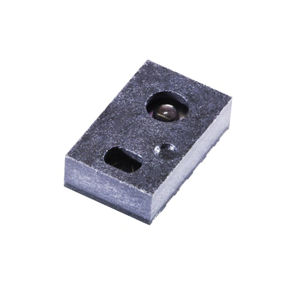
Ambient light sensor TSL25 seriesvisiblephotodiodeinfrared
Add to favorites
Compare this product
Characteristics
- Type
- ambient, visible
- Technology
- photodiode, infrared, integrated circuit, digital
- Other characteristics
- programmable
Description
Light-to-digital converter with I2C interface
Features
- Patented dual-diode architecture
- 1M:1 dynamic range
- Programmable interrupt function
- I²C digital interface
- Available in 1.25mm x 1.75mm chip-scale or 2.6mm x 3.8mm TMB or 2mm x 2mm Dual - - Flat no-lead (FN) packages
Benefits
- Enables operation in IR light environments
- Enables dark room to high lux sunlight operation
- Reduces microprocessor interrupt overhead
- Digital interface is less susceptible to noise
- Reduces board space requirements while simplifying designs
Product parameters
Supply Voltage [V]: 2.7 - 3.6
Interface: I2C - VDD
Programmable: Gain, integration time, interrupt
Max. Lux: 40000
Temperature Range [°C]: -30 to 70
Packages: (6-Pin) CL, FN, CS, T
Remark: Not recommended for new designs. Please see TSL2572x device family.
General Description
The TSL2561 is a light-to-digital converter that transforms light intensity to a digital signal output capable of an I2C interface. Each device combines one broadband photodiode (visible plus infrared) and one infrared-responding photodiode on a single CMOS integrated circuit capable of providing a near photopic response over an effective 20-bit dynamic range (16-bit resolution). Two integrating ADCs convert the photodiode currents to a digital output that represents the irradiance measured on each channel. This digital output can be input to a microprocessor where illuminance (ambient light level) in lux is derived using an empirical formula to approximate the human eye response. The TSL2561 device supports a traditional level style interrupt that remains asserted until the firmware clears it.
Catalogs
No catalogs are available for this product.
See all of AMS‘s catalogsRelated Searches
- Proximity switch
- Position transducer
- Inductive proximity switch
- Linear position transducer
- Analog output position sensor
- Non-contact position transducer
- Magnetic position transducer
- Industrial position sensor
- Metal position sensor
- Potentiometer position transducer
- Absolute position transducer
- Rotary position sensor
- Digital output position sensor
- Rugged position sensor
- Light sensor
- High-resolution position transducer
- Position sensor for automotive applications
- Compact proximity switch
- LIDAR sensor
- Machine tool position sensor
*Prices are pre-tax. They exclude delivery charges and customs duties and do not include additional charges for installation or activation options. Prices are indicative only and may vary by country, with changes to the cost of raw materials and exchange rates.








